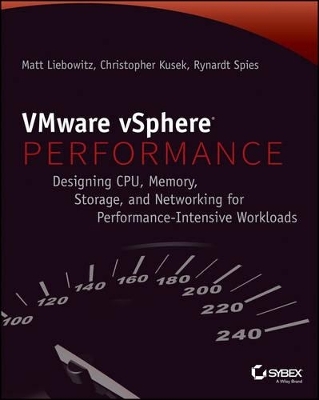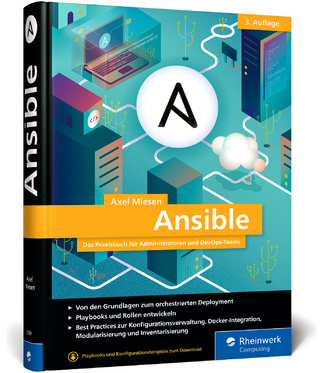
VMware vSphere Performance
John Wiley & Sons (Verlag)
978-1-118-00819-5 (ISBN)
- Titel ist leider vergriffen;
keine Neuauflage - Artikel merken
- Covering the latest VMware vSphere software, an essential book aimed at solving vSphere performance problems before they happen
- VMware vSphere is the industry's most widely deployed virtualization solution.
Covering the latest VMware vSphere software, an essential book aimed at solving vSphere performance problems before they happen VMware vSphere is the industry's most widely deployed virtualization solution.
However, if you improperly deploy vSphere, performance problems occur. Aimed at VMware administrators and engineers and written by a team of VMware experts, this resource provides guidance on common CPU, memory, storage, and network-related problems. Plus, step-by-step instructions walk you through techniques for solving problems and shed light on possible causes behind the problems.
- Divulges troubleshooting methodologies, performance monitoring tools, and techniques and tools for isolating performance problems
- Details the necessary steps for handling CPU, memory, storage, and network-related problems
- Offers understanding on the interactions between VMware vSphere and CPU, memory, storage, and network
VMware vSphere Performance is the resource you need to diagnose and handle VMware vSphere performance problems, and avoid them in the future.
Matt Liebowitz is an Advisory Solution Architect with EMC Consulting focusing on virtualizing mission-critical business applications.
Christopher Kusek is a technology visionary, VMware expert, and Internet personality.
Rynardt Spies is a Private Cloud Virtualization and Automation Consultant with one of the largest IT service providers in Europe.
Introduction xix Chapter 1 * Performance Design 1 Starting Simple 2 Determine Parameters 2 Architect for the Application 3 Assess Physical Performance 3 Start with Defaults 3 Establishing a Baseline 4 Baseline CPU Infrastructure 4 Memory 6 Network 7 Storage 9 Architecting for the Application 11 Considering Licensing Requirements 12 Integrating Virtual Machines 13 Virtual Machine Scalability 13 vMotion 13 Distributed Resource Scheduler 15 High Availability 16 Understanding Design Considerations 16 Choosing a Server 16 Summary 18 Chapter 2 * Building Your Toolbox 21 Capacity Planning Tools 21 VMware Capacity Planner 21 Microsoft Assessment and Planning Toolkit 22 Using Capacity Planning Tools 22 Ongoing Capacity Management 23 Performance Analysis Tools 26 esxtop 26 vscsiStats 31 Performance Benchmarking Tools 34 VMmark 34 vBenchmark 35 Performance Simulation Tools 36 CPU/Memory 36 Storage 38 Network 41 Summary 42 Chapter 3 * The Test Lab 45 Why Build a Test Lab? 45 Test Changes before Applying in Production 46 Test New Applications and Patches. 47 Re-Create Production Problems 48 Simulate Performance Problems for Troubleshooting 50 Benchmark New Hardware 51 Learn about Virtualization 51 Strategies for a Successful Test Lab 55 Build a Realistic Environment 55 Building the Lab 56 Use Proper Tools for Measurement 58 How to Build Your Lab 58 Test Objective 58 Lab Summary 58 Provisioning the Lab 60 Defining the Workload and Configuration of IOmeter 60 Lab Postmortem 60 Summary 61 Chapter 4 * CPU 63 Getting to Know the Basics of CPU Virtualization 63 Understanding CPU Protected Mode in the x86 Architecture 64 Defining the Types of CPU Virtualization 65 Distinguishing between Physical CPUs and Virtual CPUs 68 Understanding vCPU States 68 Introducing the ESXi CPU Scheduler 69 Understanding the Proportional Share-Based Algorithm 69 Understanding CPU Co-Scheduling 72 The CPU Scheduler Cell 73 Understanding CPU Topology-Aware Load Balancing 74 Multicore-Aware Load Balancing 82 Sizing CPU for Virtual Machines 84 Considerations for vSMP 85 Considerations for NUMA and vNUMA 86 Hot Plug of CPU Resources 86 Understanding CPU Resource Management 86 Understanding CPU Reservations 87 Understanding CPU Limits 88 Configuring CPU Reservations and Limits 88 Understanding Resource Pools 88 Troubleshooting CPU Performance Problems 91 Using esxtop to Diagnose CPU Performance Issues 91 High CPU Ready Time 93 High ESXi Host CPU Utilization 93 High Guest CPU Utilization 95 Summary 95 Chapter 5 * Memory 97 Getting to Know ESXi Memory Management 97 Memory Virtualization 98 Memory Management in ESXi 99 Hardware-Assisted MMU Virtualization 101 Reclaiming Memory from VMs 101 Transparent Page Sharing 102 Ballooning 103 Memory Compression 108 Hypervisor Swapping 111 Host SSD Cache Swapping 112 Host Memory Reclamation 114 Idle Page Reclamation 114 Managing Virtual Machine Memory Allocation 115 Working Set Size 116 Proportional Share-Based Algorithm 116 Sizing Memory for Virtual Machines 121 Memory Overhead 122 Memory Overcommitment 123 Troubleshooting Memory Performance Problems 123 Using esxtop to Diagnose Memory Performance Issues 124 High VM Consumed Memory 127 High Memory Ballooning 127 Hypervisor Swapping 128 Guest Operating System Swapping 129 Summary 130 Chapter 6 * Network 131 Creating a Network Design 131 Designing Your Physical Network 132 Choosing a Virtual Switch 133 Considering the Standard vSwitch 134 Considering the vSphere Distributed Switch 135 Considering the Cisco Nexus 1000V dvSwitch 138 Which Virtual Switch Do I Choose? 138 Selecting Host Hardware 139 Host Server Type 139 Network Adapters 141 Designing for Performance 142 ESXi Host-Level Performance 142 Virtual Machine Performance 150 Troubleshooting Networking Issues 155 Slow Virtual Machine Networking Performance 155 Summary 165 Chapter 7 * Storage 167 Choosing Your Storage Platform 167 Storage Area Networks 168 Network File System 170 Virtual SAN 171 Designing Physical Storage 172 Determine Your Requirements 172 RAID Levels 175 Flash Infrastructure Layer 180 Networking for IP Storage 180 Designing vSphere Storage 183 Why Is Storage So Important? 183 VAAI 184 Storage I/O Control 187 Storage Distributed Resource Scheduler191 Profile-Driven Storage 194 Datastore Size 199 vFlash Read Cache 200 Virtual SAN 209 Jumbo Frames for IP Storage 213 Optimizing Virtual Machine Performance 215 Raw Device Mapping vs. VMDK Files 215 Virtual Disk Type 216 Virtual SCSI Adapter 217 Guest OS Disk Alignment 220 Troubleshooting Storage Performance Issues 222 Storage Latency 223 Misconfi gured Storage for Your Applications 227 Storage Queues 228 End-to-End Networking 230 Summary 231 Index 233
| Verlagsort | New York |
|---|---|
| Sprache | englisch |
| Maße | 191 x 234 mm |
| Gewicht | 362 g |
| Einbandart | Paperback |
| Themenwelt | Informatik ► Betriebssysteme / Server ► Virtualisierung |
| Mathematik / Informatik ► Informatik ► Web / Internet | |
| Informatik ► Weitere Themen ► Hardware | |
| ISBN-10 | 1-118-00819-7 / 1118008197 |
| ISBN-13 | 978-1-118-00819-5 / 9781118008195 |
| Zustand | Neuware |
| Informationen gemäß Produktsicherheitsverordnung (GPSR) | |
| Haben Sie eine Frage zum Produkt? |
aus dem Bereich


